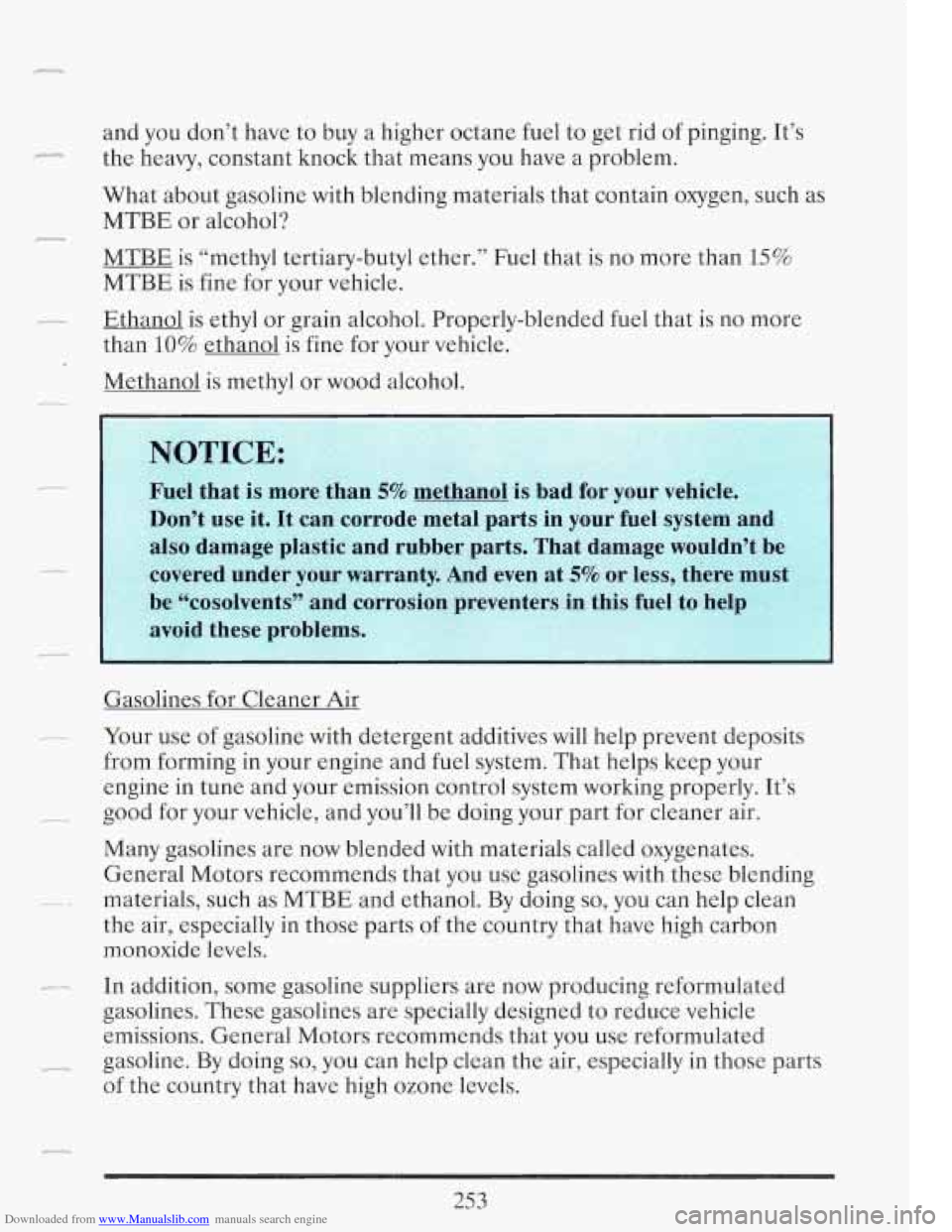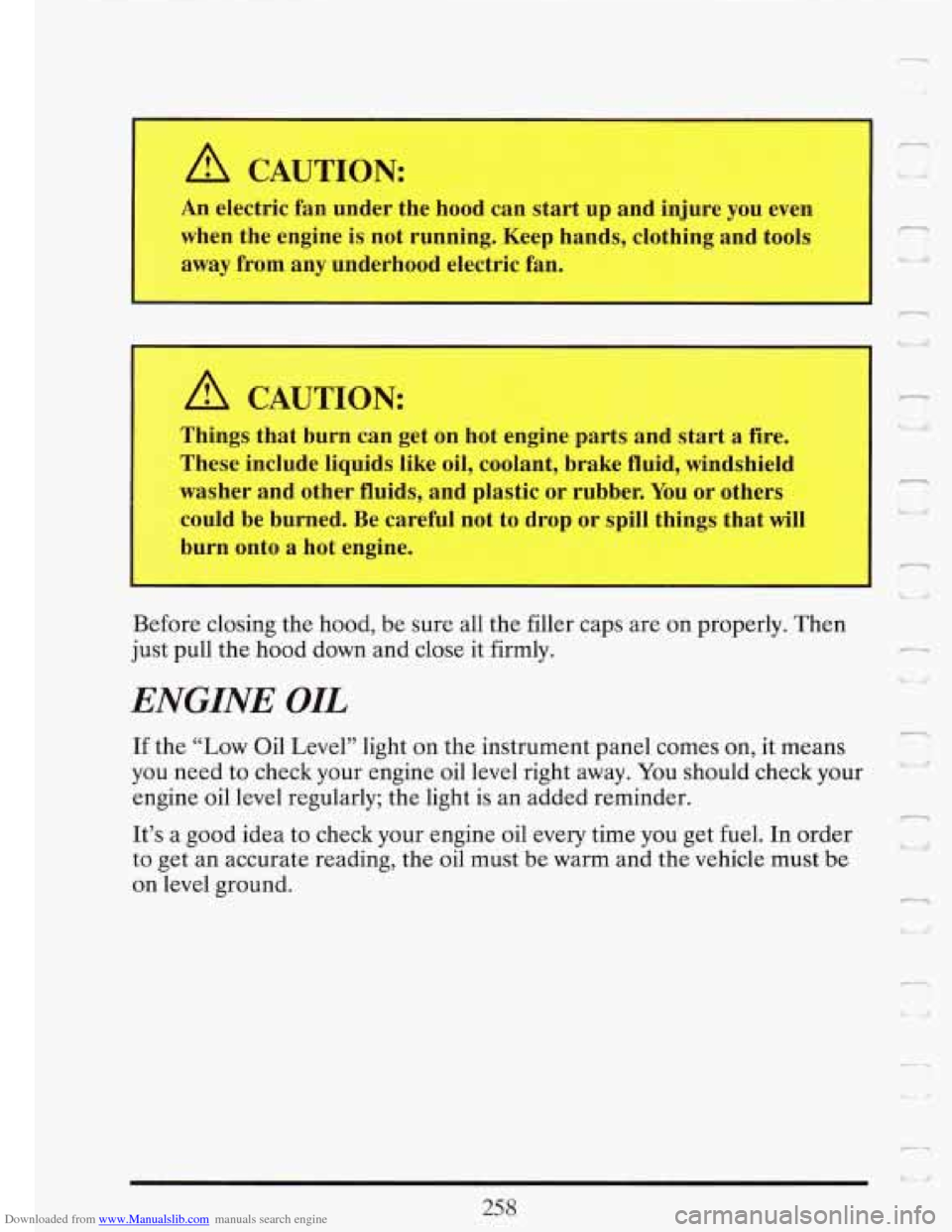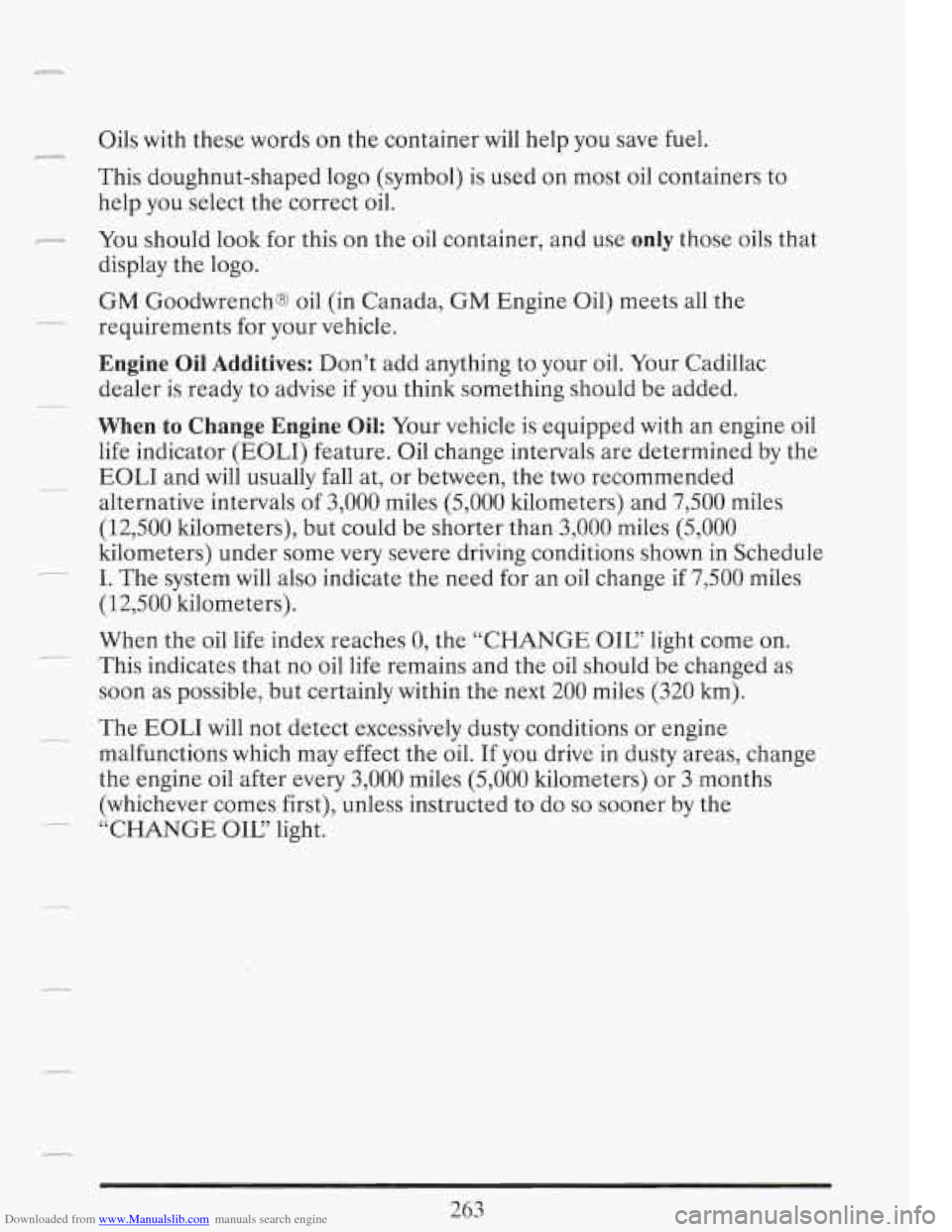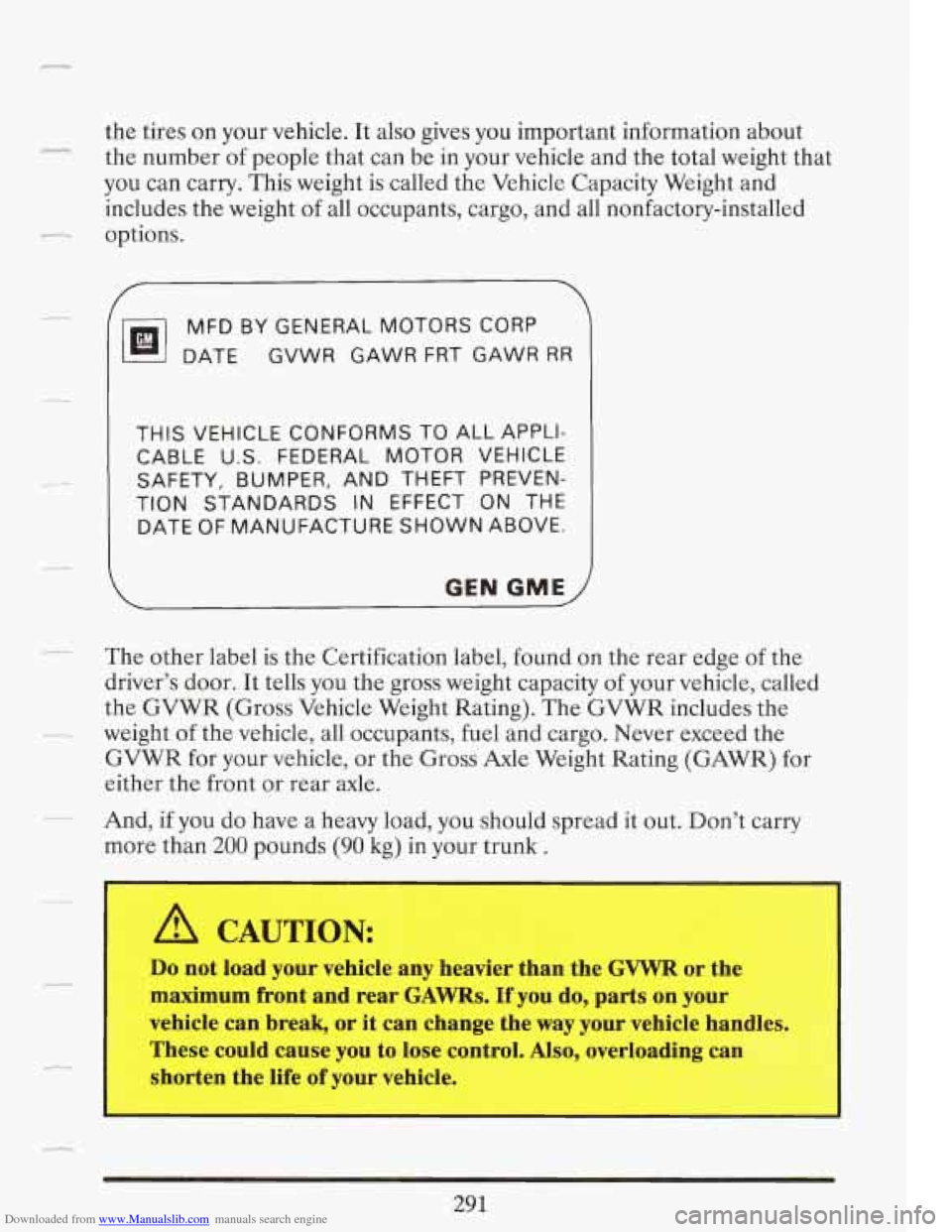Page 267 of 386

Downloaded from www.Manualslib.com manuals search engine r
J
r
and you don’t have to buy a higher octane fuel to get rid of pinging. It’s
the heavy, constant knock that means you have
a problem.
What about gasoline with blending materials that contain oxygen, such as
MTBE or alcohol?
MTBE is “methyl tertiary-butyl ether.’’ Fuel that is no more than
15%
MTBE is fine for your vehicle.
Ethanol is ethyl or grain alcohol. Properly-blended fuel that is no more
than
10% ethanol is fine for your vehicle.
Methanol is methyl or wood alcohol.
Gasolines for Cleaner &r
.. -- Your use of gasoline with detergent additives will help prevent deposits
from forming in your engine and fuel system. That helps keep your
engine
in tune and your emission control system working properly. It’s
~ good for your vehicle, and you’ll be doing your part for cleaner air.
Many gasolines are now blended with materials called oxygenates.
General Motors recommends that you use gasolines with these blending
. materials, such as MTBE and ethanol. By doing so, you can help clean
the air, especially in those parts of the country that have high carbon
monoxide levels.
c- In addition, some gasoline suppliers are now producing reformulated
- gasoline. By doing so, you can help clean the air, especially in those parts
gasolines.
These gasolines are specially designed to reduce vehicle
emissions. General Motors recommends that you use reformulated
of the country that have high ozone levels.
253
Page 268 of 386

Downloaded from www.Manualslib.com manuals search engine You should ask your service station operators if their gasolines contain
detergents and oxygenates, and if they have been reformulated to reduce
vehicle emissions.
FUELS IN FOREIGN COUNTMES
If you plan on driving in another country outside the U.S. or Canada,
unleaded fuel may be hard to find.
Do not use leaded gasoline. If you use
even one tankful, your emission controls won’t work well or at all. With
continuous use, spark plugs can get fouled, the exhaust system can
corrode, and your engine
oil can deteriorate quickly. Your vehicle’s
oxygen sensor
will be damaged. All of that means costly repairs that
wouldn’t be covered by your warranty.
To check on fuel availability, ask an auto club, or contact a major oil
company that does business in the country where you’ll be driving.
You can also write us at the following address for advice. Just tell
us
where you’re going and give your Vehicle Identification Number (VIN).
General Motors of Canada Ltd.
International Export Sales
PO. Box 828
Oshawa, Ontario L1H 7N1, Canada
n
Li
c
L4 , ,t
‘i nl
254
Page 269 of 386
Downloaded from www.Manualslib.com manuals search engine ,s-- FILLING YOUR TANK
A CAUTION:
Gasoline vapor is highly flammable. It burns violently, and that
can cause very bad injuries. Don’t smoke if you’re near gasoline
or if you’re refueling your vehicle. Keep sparks, flames, and
I
smoking materials away from gasoline.
c_ If you’re refueling your tank using a hydrocarbon recovery nozzle, the
fuel pump may shut off before the fuel capacity of your tank reaches full.
This is a normal condition. If you slow the
flow of fuel going into the
tank, it is more likely to fill to capacity without shutting off.
__
Locking Fuel Filler Door (Option)
m Your vehicle may have the locking fuel filler door.
The cap is behind the license plate. Pull down from the top of the license
plate bracket door to open.
255
Page 270 of 386
Downloaded from www.Manualslib.com manuals search engine The filler door is
locked and unlocked
every time you use the
I power door locks. If
pushing
the power lock _a
switch doesn’t unlock w
or lock the fuel filler
door, you can use the
manual lock release
lever,
in the trunk.
Move the lever to the
left to unlock the fuel
filler
door.
To take off the cap, turn it slowly to the left (counterclockwise).
I
A CAUTION:
If you get gasoline on you and then something ignites it, you
could be badly burned. Gasoline can spray out on you
if you
open the fuel filler cap too quickly. This spray can happen if
your tank is nearly
full, and is more likely in hot weather. Open
the fuel filler cap slowly and wait for any “hiss” noise to stop.
Then unscrew the cap all the
way.
When you put the cap back on, turn it to rhe rlgnt untu you near a
clicking noise
W
r
W
P
L- .&
U
7.
256
Page 272 of 386

Downloaded from www.Manualslib.com manuals search engine A CAUTION:
An electric fan under the hood can start up and injure you even
when the engine is not running. Keep hands, clothing and tools
away from any underhood electric fan.
A CAUTION:
Things that burn can get on hot engine parts and start a fire.
These include liquids like oil, coolant, brake fluid, windshield
washer and other fluids, and plastic or rubber.
You or others
could be burned. Be careful not to drop or spill things that will
burn onto
a hot engine.
I
Before closing the hood, be sure all the filler caps are on properly. Then
just pull the hood down and close it firmly.
ENGINE OIL
If the “Low Oil Level” light on the instrument panel comes on, it means
you need to check your engine oil level right away. You should check your
engine oil
level regularly; the light is an added reminder.
It’s a good idea to check your engine oil every time you get
fuel. In order
to get an accurate reading, the oil must be warm and the vehicle must be
on level ground. c1
u
Page 276 of 386
Downloaded from www.Manualslib.com manuals search engine -
RECOMMENDED SAE VISCOSITY GRADE ENGINE OILS
L
FOR BEST FUEL ECONOMY AND COLD STARTING, SELECT THE LOWEST
SAE VISCOSITY GRADE OIL FOR THE EXPECTED TEMPERATURE RANGE.
HOT
WEATHER
+ BO
"C
+ 38
+27
- SAE I 1OW-30
( $ J PREFERRED
SAE SW-30
IF NEITHER SAE 5W-30 NOR SAE 1OW-30
COLD
WEATHER GRADE OILS ARE AVAILABLE, SAE 30
GRADE MAY BE USED AT TEMPERATURES
ABOVE
40 DEGREES F (4 DEGREES C).
DO NOT USE SAE 1OW-40 GRADE OIL OR
ANY OTHER GRADE NOT RECOMMENDED
n
'e I
F
-+I
JT
Lj
These numbers on an oil container show its viscosity, or thickness. Do not
use other viscosity oils such as
SAE 1OW-40 or SAE 20W-50. n
Energy Conserving I1
262
Page 277 of 386

Downloaded from www.Manualslib.com manuals search engine .-
Oils with these words on the container will help you save fuel.
This doughnut-shaped logo (symbol) is used on most oil containers to
help you select the correct oil.
You should look for this on the
oil container, and use only those oils that
display the logo.
GM Goodwrench@ oil (in Canada, GM Engine Oil) meets all the
requirements for your vehicle.
Engine Oil Additives: Don’t add anything to your oil. Your Cadillac
dealer
is ready to advise if you think something should be added.
When to Change Engine Oil: Your vehicle is equipped with an engine oil
life indicator (EOLI) feature. Oil change intervals are determined by the
EOLI and will usually fall at, or between, the two recommended
alternative intervals of
3,000 miles (5,000 kilometers) and 7,500 miles
(12,500 kilometers), but could be shorter than 3,000 miles (5,000
kilometers) under some very severe driving conditions shown in Schedule
I. The system will also indicate the need for an oil change
if 7,500 miles
(12,500 kilometers).
When the oil life index reaches
0, the “CHANGE OII? light come on.
This indicates that no oil life remains and the oil should be changed as
soon as possible, but certainly within the next
200 miles (320 km).
The EOLI will not detect excessively dusty conditions or engine
malfunctions which may effect the
oil. If you drive in dusty areas, change
the engine oil after every
3,000 miles (5,000 kilometers) or 3 months
(whichever comes first), unless instructed to do
so sooner by the
“CHANGE
OW light.
263
Page 305 of 386

Downloaded from www.Manualslib.com manuals search engine the tires on your vehicle. It also gives you important information about
the number of people that can be in your vehicle and the total weight that
you can carry. This
weight is called the Vehicle Capacity Weight and
includes the weight
of all occupants, cargo, and all nonfactory-installed
options.
MFD BY GENERAL MOTORS CORP
DATE GVWR GAWR FRT GAWR
RR
THIS VEHICLE CONFORMS TO ALL APPLI-
CABLE
U.S. FEDERAL MOTOR VEHICLE
TION STANDARDS
IN EFFECT ON THE
DATE OF MANUFACTURE SHOWN ABOVE.
SAFETY, BUMPER,
AND THEFT PREVEN-
GEN GME /
The other label is the Certification label, found on the rear edge of the
driver’s door. It tells you the gross weight capacity of your vehicle, called
the
GVWR (Gross Vehicle Weight Rating). The GVWR includes the
weight of the vehicle, all occupants, fuel and cargo. Never exceed the
GVWR for your vehicle, or the Gross Axle Weight Rating (GAWR) for
either the front or rear axle.
And,
if you do have a heavy load, you should spread it out. Don’t carry
more than
200 pounds (90 kg) in your trunk .
A CAUTION:
Do not load your vehicle any heavier than the GVWR or the
vehicle can break, or it can change the way your vehicle handles.
These could cause you to lose control.
Also, overloading can
shorten the life
of your vehicle.
I maximum front and rear GAWRs. If you do, parts on your
I
291